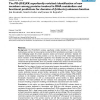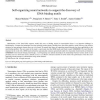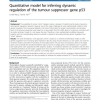17 search results - page 3 / 4 » Structure-Function Relationship in DNA Sequence Recognition ... |
BMCBI
2005
13 years 7 months ago
2005
Background: The PD-(D/E)XK nuclease superfamily, initially identified in type II restriction endonucleases and later in many enzymes involved in DNA recombination and repair, is o...
NN
2006
Springer
13 years 7 months ago
2006
Springer
Identification of the short DNA sequence motifs that serve as binding targets for transcription factors is an important challenge in bioinformatics. Unsupervised techniques from t...
BMCBI
2010
13 years 7 months ago
2010
Background: The availability of various "omics" datasets creates a prospect of performing the study of genomewide genetic regulatory networks. However, one of the major ...
BMCBI
2007
13 years 7 months ago
2007
Background: This work explores the quantitative characteristics of the local transcriptional regulatory network based on the availability of time dependent gene expression data se...
JCB
2002
13 years 7 months ago
2002
At least 43% of the human genome is occupied by repetitive elements. Moreover, around 51% of the rice genome is occupied by repetitive elements. The analysis of repetitive element...



